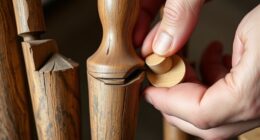To measure accurately, focus on understanding fractional markings, such as 1/16, 1/8, or 1/4, and convert them to decimals when needed. Always pay close attention to the smallest lines for precise reading. When working with backside scales, adjust your perspective or flip the tape to interpret reversed markings correctly. With careful focus and practice, you’ll improve your measurements—keep exploring for more tips and techniques to master this skill.
Key Takeaways
- Focus on the closest small line to the measurement mark on the main scale for precise readings.
- Convert fractional markings (e.g., 1/8, 1/16) into decimals for improved measurement accuracy.
- Practice flipping or adjusting perspective to accurately read reversed backside scales.
- Recognize and interpret all fractional divisions on both front and backside scales accurately.
- Use durable, well-marked tape measures to ensure consistent readings and reduce measurement errors.

Have you ever struggled to read a tape measure accurately? If so, you’re not alone. Many people find themselves squinting at tiny markings or second-guessing whether they’re reading the right side of the tape. Achieving measurement precision is essential for any project, whether you’re hanging pictures or doing woodworking. A big part of that accuracy depends on understanding how to interpret the fractions and backside scales on your tape measure. Plus, knowing that your tape measure is made from durable materials helps guarantee consistent, reliable readings over time. Quotes from explorers often emphasize the importance of precise navigation and attention to detail, which can be applied to reading measurements carefully.
Understanding fractions and backside scales ensures accurate measurements and reliable results over time.
When you’re reading a tape measure, it’s important to recognize the different types of markings. The main side usually shows inches divided into fractions—1/16, 1/8, 1/4, and so on. To get precise measurements, you need to be able to distinguish these small lines and convert fractions into decimals if needed. For example, knowing that 1/8 inch is the same as 0.125 inches helps when you’re working on detailed tasks. The key is to focus on the line closest to your measurement mark, ensuring you’re reading the fraction correctly. This focus minimizes errors and boosts measurement precision.
Sometimes, the measurement isn’t on the main side but on the backside of the tape. Backside scales are often used for interior measurements or when measuring around corners. These scales can be tricky because they’re upside down or reversed, but with practice, you get used to flipping your perspective. To read them accurately, you might need to slightly turn your head or position the tape differently. Remember, these scales often follow the same fractional system as the front, so understanding the fractions helps you interpret the backside measurements with confidence. This versatility is essential for complex projects where accurate measurements from different angles make all the difference.
Material durability also plays a crucial role in maintaining measurement accuracy. A tape measure made from sturdy, flexible materials like steel or high-quality fiberglass resists bending, warping, and wear over time. When your tape measure is durable, the markings stay clear and intact, preventing misreads. A well-made tape ensures that the measurements you take today remain reliable after months of use. Investing in a durable tape measure means you won’t have to worry about inaccuracies caused by a bent or worn-out tape. Instead, you can focus on making precise cuts and measurements, confident that your tool will serve you well throughout your projects. Recognizing the importance of explorers’ resilience and attention to detail can inspire careful measurement practices akin to navigation through uncharted territories.
Frequently Asked Questions
How Do I Convert Fractional Measurements to Decimal?
To convert fractional measurements to decimal, you need to perform a fraction conversion. Divide the numerator by the denominator, and you’ll get your decimal value. For example, if you have 3/4, divide 3 by 4 to get 0.75. This method guarantees decimal accuracy, making it easier to read tape measures precisely. Practice this conversion regularly, and you’ll improve your ability to quickly interpret fractional measurements on tape measures.
What Is the Best Way to Read Tricky Backside Scales?
To read tricky backside scales, focus on mastering backside scale techniques and reading mirror scales. Position the tape measure so you can clearly see the mirror or backside, then align your eye level with the scale for accurate reading. Use a flashlight or good lighting if needed, and practice frequently to develop a steady hand and sharp eye. This helps you quickly interpret measurements without confusion.
Are Digital Tape Measures More Accurate Than Traditional Ones?
Digital tape measures are generally more accurate than traditional ones, thanks to digital accuracy and easier readability. You get precise measurements instantly, reducing human error. Traditional reliability, however, offers proven durability and simplicity without batteries or electronics. Whether you choose digital or traditional depends on your needs—opt for digital for quick, precise readings, or stick with traditional for dependable, long-lasting performance. Both types can serve you well if used correctly.
How Can I Prevent Tape Measure Errors During Measurements?
To prevent tape measure errors, regularly use calibration techniques to verify accuracy and check for wear or damage. Store your tape measure properly in a dry, cool place to avoid warping or corrosion. Always lock the tape when measuring to prevent slipping, and double-check measurements for precision. Maintaining your tape measure and practicing these storage practices help you get consistent, accurate readings every time.
What Materials Are Most Durable for Long-Lasting Tape Measures?
Did you know that steel tape measures can last over 20 years with proper care? For long-lasting tapes, choose materials like stainless steel or fiberglass, which excel in durability and resistance to wear and tear. These materials maintain their shape, resist rust, and withstand harsh conditions, making them ideal for demanding projects. Investing in a tape measure with high-quality material durability guarantees your tool remains reliable for years to come.
Conclusion
Now that you’re familiar with reading fractions and backside scales, you’re well on your way to mastering your tape measure. With a little practice, you’ll find it’s easier than it seems—like uncovering a hidden secret. Remember, patience is your best tool, and soon you’ll measure with confidence and precision. Keep at it, and you’ll turn those tiny marks into your trusted allies for any project. Happy measuring!









